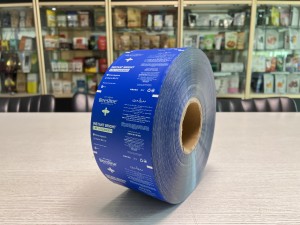Custom Printed Rewind Film Roll Sechat Package
What is Film Roll
Film Roll may not have a clear and strict definition in the packaging industry, but it is a game changer that changes the way plastic packaging is done. This is an efficient and cost-effective way of packaging products, especially for small packaging needs.
Film Roll is a type of plastic packaging that requires one less process in the finished bag. The types of materials used for Film Roll are the same as those for plastic packaging bags. There are different types of Film Roll, such as PVC shrink film Film Roll, opp Film Roll, pe Film Roll, pet protective film, composite Film Roll, etc. These types are commonly used in automatic packaging machines, such as those used to pack shampoo, wet wipes, and other similar products in pouches. The use of film reduces the need for manual labor, thereby saving costs.
These two-layer material packaging roll films have the following properties and functions: 1. PET/PE materials are suitable for vacuum packaging and modified atmosphere packaging of products, which can improve food freshness and extend shelf life; 2. OPP/CPP materials have good transparency and tear resistance, and are suitable for packaging of candy, biscuits, bread and other products; 3. Both PET/PE and OPP/CPP materials have good moisture-proof, oxygen-proof, fresh-keeping and corrosion-resistant properties, which can effectively protect the products inside the package; 4. The packaging film of these materials has good mechanical properties, can withstand certain stretching and tearing, and ensures the integrity and stability of the packaging; 5. PET/PE and OPP/CPP materials are environmentally friendly materials that meet food safety and hygiene requirements and will not pollute the products inside the package.
The application of Film Roll on automatic packaging machinery does not require any edge banding work by the packaging manufacturer. A single edge banding operation is sufficient for the manufacturer. Therefore, packaging manufacturers only need to perform printing operations. Since the product is supplied in rolls, transportation costs are reduced. Printing and packaging companies can save significantly by using Film Roll.
The main advantage of Film Roll applied to the packaging industry is to save the cost of the entire packaging process. In the past, the process involved multiple steps, from printing to shipping to packaging. With Film Roll, the entire process is simplified into three major steps of printing-transportation-packaging, which greatly simplifies the packaging process and reduces the cost of the entire industry.
Another advantage of film is that it is easy to store and handle. Since the material is supplied in rolls, it is easy to store and transport. This makes the handling and distribution of products more efficient and ultimately saves costs.
Film is also environmentally friendly as it can be recycled and reused. The material is durable and can withstand varying environmental conditions, making it a more sustainable choice over time.
In conclusion, film is a revolutionary product that simplifies the way we package our products. This is an efficient and cost-effective way of packaging products, especially for small packaging needs. Film Roll facilitates storage, handling and shipping, reducing the overall cost of the packaging process. It is an eco-friendly packaging option that can be recycled and reused, making it a more sustainable choice over time. With these advantages, roll film is the first choice of packaging manufacturers looking to reduce costs and simplify the packaging process.
Deliver,Shipping and Serving
By sea and express, also you can choose the shipping by your forwarder.It will take 5-7 days by express and 45-50 days by sea.
1. What is film roll production?
Film roll production is the process of creating a continuous roll of film material that can be used for a variety of applications, such as packaging, labeling, or graphics printing. The process typically involves extruding plastic or other materials, applying coatings or finishes, and winding the material onto a spool or core.
2. What factors influence Film roll design?
Film roll design is influenced by several factors, including the type of application, the desired properties of the film (e.g. strength, flexibility, barrier properties), and the machinery or equipment used to produce or process the film. Other factors may include cost considerations and environmental concerns.
3. What are some common delivery issues in Film roll production?
Delivery issues in Film roll production may include delays or disruptions in the supply chain, such as shortages of raw materials or shipping delays. Quality control issues may also arise, such as defects in the film or poor packaging that leads to damage during transport. Communication breakdowns or misunderstandings between suppliers and customers can also cause delivery problems.
4. How does Film roll production impact the environment?
Film roll production can have environmental impacts, including the use of non-renewable resources, such as petroleum or other fossil fuels, in the production of plastic films. Additionally, the process may generate waste, such as trimmings or scraps, which may end up in landfills or other disposal sites. However, some companies are working to reduce their environmental footprint by using recycled or biodegradable materials and implementing sustainable practices.
5. What are some emerging trends in Film roll production?
Emerging trends in Film roll production include the use of advanced materials, such as nanocomposites and bioplastics, that offer improved physical properties and reduced environmental impact. Automation and robotics are also playing an increasing role in Film roll production, allowing for greater efficiency, consistency, and flexibility in manufacturing. Lastly, digital printing technologies are enabling more customized and personalized printing solutions, opening up new opportunities for Film roll producers and their customers.














